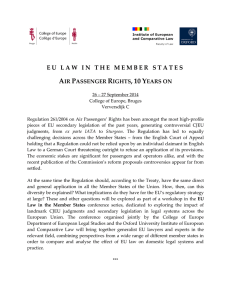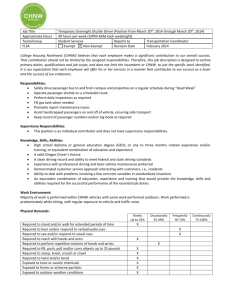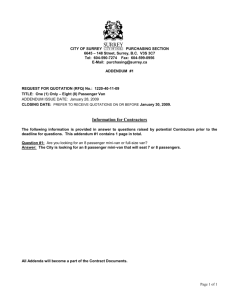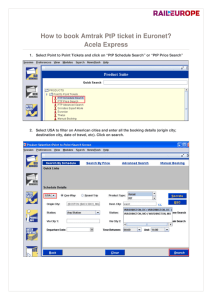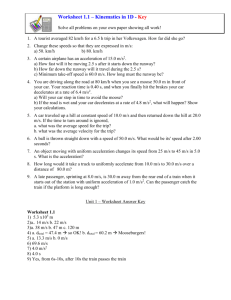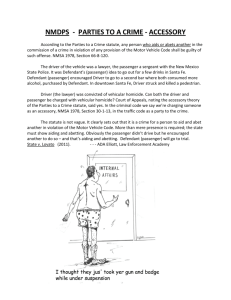the Contributed Poster
advertisement
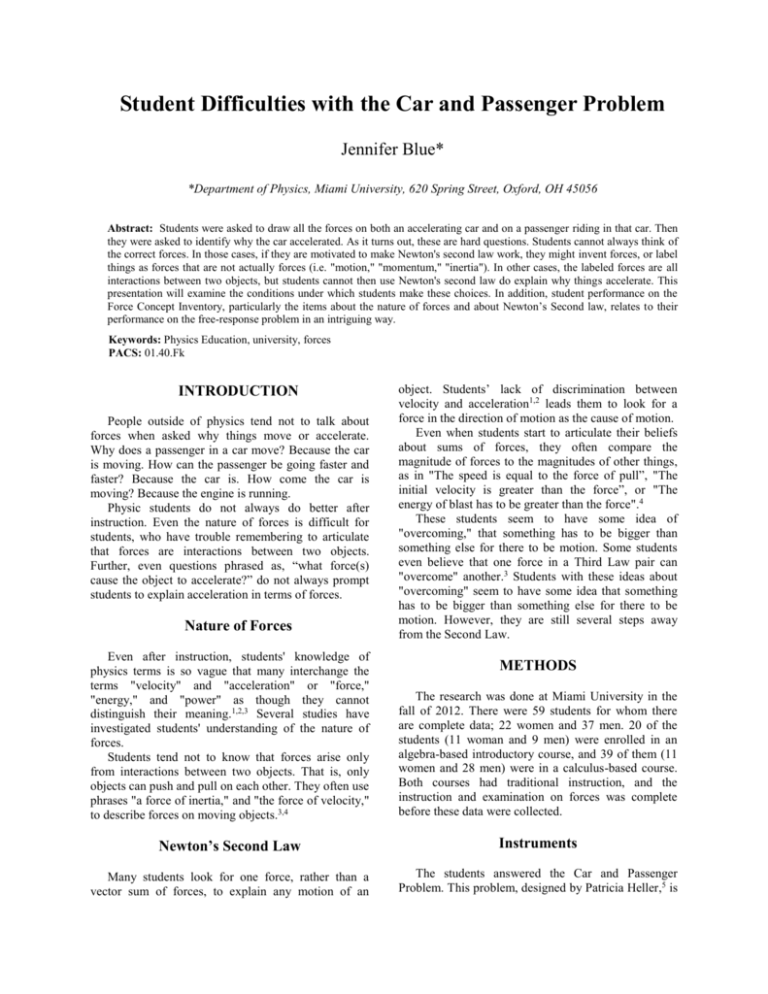
Student Difficulties with the Car and Passenger Problem Jennifer Blue* *Department of Physics, Miami University, 620 Spring Street, Oxford, OH 45056 Abstract: Students were asked to draw all the forces on both an accelerating car and on a passenger riding in that car. Then they were asked to identify why the car accelerated. As it turns out, these are hard questions. Students cannot always think of the correct forces. In those cases, if they are motivated to make Newton's second law work, they might invent forces, or label things as forces that are not actually forces (i.e. "motion," "momentum," "inertia"). In other cases, the labeled forces are all interactions between two objects, but students cannot then use Newton's second law do explain why things accelerate. This presentation will examine the conditions under which students make these choices. In addition, student performance on the Force Concept Inventory, particularly the items about the nature of forces and about Newton’s Second law, relates to their performance on the free-response problem in an intriguing way. Keywords: Physics Education, university, forces PACS: 01.40.Fk INTRODUCTION People outside of physics tend not to talk about forces when asked why things move or accelerate. Why does a passenger in a car move? Because the car is moving. How can the passenger be going faster and faster? Because the car is. How come the car is moving? Because the engine is running. Physic students do not always do better after instruction. Even the nature of forces is difficult for students, who have trouble remembering to articulate that forces are interactions between two objects. Further, even questions phrased as, “what force(s) cause the object to accelerate?” do not always prompt students to explain acceleration in terms of forces. Nature of Forces object. Students’ lack of discrimination between velocity and acceleration1,2 leads them to look for a force in the direction of motion as the cause of motion. Even when students start to articulate their beliefs about sums of forces, they often compare the magnitude of forces to the magnitudes of other things, as in "The speed is equal to the force of pull”, "The initial velocity is greater than the force”, or "The energy of blast has to be greater than the force".4 These students seem to have some idea of "overcoming," that something has to be bigger than something else for there to be motion. Some students even believe that one force in a Third Law pair can "overcome" another.3 Students with these ideas about "overcoming" seem to have some idea that something has to be bigger than something else for there to be motion. However, they are still several steps away from the Second Law. Even after instruction, students' knowledge of physics terms is so vague that many interchange the terms "velocity" and "acceleration" or "force," "energy," and "power" as though they cannot distinguish their meaning.1,2,3 Several studies have investigated students' understanding of the nature of forces. Students tend not to know that forces arise only from interactions between two objects. That is, only objects can push and pull on each other. They often use phrases "a force of inertia," and "the force of velocity," to describe forces on moving objects.3,4 The research was done at Miami University in the fall of 2012. There were 59 students for whom there are complete data; 22 women and 37 men. 20 of the students (11 woman and 9 men) were enrolled in an algebra-based introductory course, and 39 of them (11 women and 28 men) were in a calculus-based course. Both courses had traditional instruction, and the instruction and examination on forces was complete before these data were collected. Newton’s Second Law Instruments Many students look for one force, rather than a vector sum of forces, to explain any motion of an The students answered the Car and Passenger Problem. This problem, designed by Patricia Heller,5 is METHODS shown in Figure 1. Parts (a) and (c) of the question, drawing and labeling the forces, serve as an indirect measure of students' understanding of the nature of forces. Students who draw forces that are all really acting on either the car or the passenger and that arise from an interaction between two objects have a correct understanding of the nature of forces. Parts (b) and (d), explaining why the car and passenger accelerate, is a more direct measure of students' understanding of Newton's second law. Students who describe a vector sum of forces in the direction of motion and in the opposite direction have a correct understanding of Newton's second law. You are a passenger in a car that is traveling on a straight road while it is increasing speed from 30 mph to 55 mph. You wonder what forces cause you and the car to accelerate. When you pull over to eat, you decide to figure it out. (a) Draw and label arrows representing all the forces acting on you (passenger) while the car is accelerating. Describe each force in words. (b) Which force(s) cause you (passenger) to accelerate? Explain your reasoning. (c) Draw and label arrows representing all the forces acting on the car while it is accelerating. Describe each force in words. (d) Which force(s) cause the car to accelerate? Explain your reasoning. FIGURE 1. The Car and Passenger Problem. In addition, students took the Force Concept Inventory (FCI).3 Table II from that paper, “Taxonomy of Naïve Conceptions Probed by the FCI” has been updated.6 One of those conceptions was that “only active agents exert forces”. Students with that conception seem likely to have difficulties with sections (a) and (c) on the Car and Passenger Problem. There are 4 questions with answers that would indicate that students hold that misconception. These questions and answers are listed in Figure 2. Analysis Student answers on each of the four parts of the Car and Passenger Problem were analyzed separately, with responses that indicated an understanding of the nature of forces were marked as correct for parts (a) and (c) and that responses that indicated an understanding of Newton’s Second Law were marked as correct for parts (b) and (d). This meant that an answer to part (b) that read, “The momentum of the car pushes them forwards. As this force is greater than resisting inertia, the passenger accelerates,” was marked as correct, despite the student’s difficulties with the nature of forces. Students received scores of 0 or 1 for each part of the problem, resulting in total scores on the problem that ranged from 0 to 4. A preliminary analysis showed 15. A large truck breaks down out on the road and receives a push back into town by a small compact car. While the car, still pushing the truck, is speeding up to get up to cruising speed: (D) the car’s engine is running so it applies a force as it pushes against the truck, but the truck’s engine isn’t running so it can’t push back against the car. The truck is pushed forward simply because it is in the way of the car. 16. A large truck breaks down out on the road and receives a push back into town by a small compact car. After the car reaches the cruising speed at which its driver wishes to continue to push the truck: (D) same as for question 15. 17. An elevator is being lifted up in an elevator shaft at a constant speed by a steel cable. All frictional effects are negligible. In this situation, forces on the elevator are such that: (E) the elevator goes up because the cable is being shortened, not because an upward force is being exerted on the elevator by the cable. 28. Two students, “a” who has a mass of 95 kg and “b” who has a mass of 77 kg sit in identical office’ chairs facing each other. Student “a” places his feet on “b’s” knees, then suddenly pushes outward with his feet, causing both chairs to move. During the push and while the students are still touching one another: (B) student “a” exerts a force on “b”, but “b” does not exert any force on “a”. FIGURE 2. FCI questions probing the conception that only active agents are able to exert forces. no differences between men and women or between students in the algebra-based and calculus-based courses. Student scores on the Car and Passenger Problem were compared to the scores on the Force Concept Inventory, both the total score (out of 30) and the score on the four questions listed earlier (out of 4). Finally, an analysis was made of those students who did better on the nature of forces parts of the problem than the Second Law parts, and vice versa. RESULTS There were 59 students who completed all four sections of the Car and Passenger Problem and took the Force Concept Inventory. The four parts of the Car and Passenger Problem were analyzed separately. The students drew and labeled a total of 78 horizontal forces on the passenger. For the purposes of this analysis, the vertical forces students drew on the passenger were ignored. About 40% of the horizontal forces drawn on the passenger were labeled friction or normal forces; though these were not explicitly labeled as interactions between two objects, they could be. A few students included forces of the passenger acting on the car on their diagrams. More than half of the horizontal forces students drew on the passenger were not interactions between two objects. In the direction of acceleration there were 19 forces labeled “car”, and 11 forces labeled motion, velocity, acceleration, or momentum. In the direction opposing motion, there were 3 forces labeled “car”, 6 labeled motion, momentum, or acceleration, and 7 labeled inertia. These labeled forces are summarized in Table 1. TABLE 1. Description of forces on the passenger Description of Forces on Passenger N % Friction or normal 19 24 in direction of acceleration Friction or normal opposing 13 17 acceleration Passenger acting on car 4 5 Not interactions between 2 objects 42 54 Total 78 100 In part (b) of the Car and Passenger Problem, students answered the question, “What force(s) cause you (passenger) to accelerate?” Only 6 students (10%) answered by summing forces they had labeled on their diagram. (Recall that some of these sums were of the “motion is larger than inertia” variety.) A further 32% of students attributed the passenger’s acceleration to the only force on the diagram, a force in the direction of motion. This was also counted as correct, as it is likely the response that most experts would give. About 40% of the students did not answer the question, which was explicitly about forces, with one or more forces; many of them said that the passenger accelerates just because it’s in the car, and a few said that the passenger does not accelerate. These responses are summarized in Table 2. TABLE 2. Reason the passenger accelerates Reason the Passenger Accelerates N % 2nd Law - compares 2 horizontal 6 10 arrows on diagram One force – the only horizontal 19 32 arrow, in direction of acceleration One force, though there is more than 8 14 one horizontal arrow on diagram Compares horizontal to vertical, or 2 3 compares “forces” not on diagram Because the car accelerates 20 34 The passenger does not accelerate 4 7 Total 59 100 The 98 student labels of the horizontal forces on the car are summarized in Table 3. Again, the vertical forces students drew are ignored in this analysis. 11% of the horizontal forces were labeled as frictional forces on the car in the direction of acceleration; this is a much smaller number than the 47% labeled friction or drag opposing acceleration. 9% were the car acting on the road, 3% in the direction of acceleration and 6% in the opposite direction. The remaining 33% were labeled as something besides interactions between two objects, and all of these were in the direction of acceleration. Of these, about half were labeled as “car” or “engine”, and the rest were labeled as motion, velocity, acceleration, or momentum. TABLE 3. Description of forces on the car Description of Forces on Car N % Friction in direction of acceleration 11 11 Friction or drag opposing 46 47 acceleration Car acting on ground 9 9 Not interactions between 2 objects 32 33 Total 98 100 The responses given to the question about which force(s) cause the car to accelerate are summarized in Table 4. 24% of the students who summed 2 horizontal forces on the diagram and a further 8% named their only horizontal force on the diagram, one that was pointing in the direction of acceleration. A majority of students, 54%, listed forces in an incorrect way, and 14% of students did not cite anything they had included on their diagrams. TABLE 4. Reason the car accelerates Reason the Car Accelerates N 2nd Law - compares 2 horizontal 14 arrows on diagram One force – the only horizontal 5 arrow, in direction of acceleration One force, though there is more than 25 one horizontal arrow on diagram and/or the force opposes acceleration Compares horizontal to vertical, or 7 compares “forces” not on diagram Because of the engine or other 8 internal “force” not on diagram Total 59 % 24 8 42 12 14 100 Comparisons to the FCI It was possible to score a high of 4 on the Car and Passenger Problem, if students got parts (a)-(d) all correct. Only 2 of the 59 students did score 4, and just 2 more scored 3. There were 15 who scored 2 points, 20 who scored 1, and 20 who scored 0. TABLE 5. Comparison of C & P Problem to FCI Score on Car/Passenger Problem N FCI mean 0 20 16.0 1 20 18.8 2, 3, or 4 19 19.3 The students also took the Force Concept Inventory. Table 5 shows the comparison of the scores on the Car and Passenger Problem to those on the FCI. Students with higher scores on the Car and Passenger Problem also have higher scores on the FCI. A one- way ANOVA was used to test for differences in the FCI mean among the three groups. The differences were not significant, F(2, 26)= 1.662, p = 0.199. As stated above and illustrated in Fig. 2, there are 4 FCI questions with distractors that probe student beliefs that only active agents can exert forces. Student scores on parts (a) and (c) of the Car and Passenger Problem, concerning the nature of forces on the passenger and the car, were compared to the mean scores on both the whole FCI and the mean score on just those 4 questions. These comparisons are shown in Table 6. TABLE 6. Student score on parts (a) and (c) compared to “only active agents exert forces” choices on the FCI Score on parts (a) and (c) 0 1 2 N 41 16 2 FCI mean 16.8 20.2 24.0 Mean on Q 15, 16, 17 & 28 2.2 2.7 3.5 N with “only active agents” choices 11 1 0 The numbers of students are wildly different in the three categories, making statistical tests difficult, but there is a slight increase in both means as the scores increase. In addition, almost everyone who chose one of the distractors that indicated that they believe only active agents scored 0, not labeling correct forces on either thes passenger or the car. Choosing between Real Forces and Newton’s Second Law Judging from student responses to the Car and Passenger Problem after instruction, it is difficult both to identify the forces acting on the car and the passenger and to use Newton’s Second Law to explain their accelerations. A summary of correct answers on the problem is shown in Table 7. Note that students did better at answering questions about why the car and passenger accelerate than on correctly identifying forces. They also did better answering questions about the passenger than about the car. TABLE 7. Percentage of correct answers Piece of Car and Passenger Problem % Correct (a) Nature of forces on passenger 24% (b) Why passenger accelerates 42% (c) Nature of forces on car 11% (d) Why car accelerates 32% As can be seen in Table 5, few students got more than one or two parts of the problem correct. On the passenger, 8% of students got the nature of forces correct but did not use Newton’s Second Law correctly, but 27% used the Second Law well with incorrect forces. On the car, 5% of students got the nature of forces correct but did not use Newton’s Second Law correctly. There were no students in that group who made the same mistakes on the passenger. 27% of students used the Second Law well with incorrect forces when they talked about the car, with 5% of them having made the same mistake on the passenger. DISCUSSION Even after instruction, fewer than half of the students studied did not correctly apply Newton’s Second Law to the question of why the car and passenger accelerate. The question of how objects are propelled forward is known to be difficult, though is a well-researched technique available for teaching this.7 Even fewer students correctly identified all of the horizontal forces on the accelerating car and passenger. Further research is needed. Do students draw these non-forces on their diagrams right away? Or do they come to parts (b) and (d), realize they have not included a real force in the direction of acceleration, and then add the forces of car, engine, motion, velocity, acceleration, and momentum? Conducting interviews where students think aloud as they solve the Car and Passenger Problem would be useful. They could help determine the order in which students do this problem, and therefore illuminate their thought processes. ACKNOWLEDGMENTS Thanks to Patricia Heller for the Car and Passenger Problem, as well as for her continued support since the start of my career. And thanks to Laurence Viennot for an insightful discussion of the ideas in this paper. REFERENCES 1. D.E. Trowbridge & L.C. McDermott, American Journal of Physics 48(12), 1020-1028 (1980). 2. D.E. Trowbridge & L.C. McDermott, American Journal of Physics 9(1), 242-253 (1981). 3. D. Hestenes, M. Wells, & G. Swackhamer, The Physics Teacher 30, 141-158 (1992). 4. I.A. Halloun & D. Hestenes, American Journal of Physics, 53(11), 1056-1065 (1985). 5. J. Blue, “Sex Differences in Learning and Evaluations in an Introductory University Physics Course”, Ph.D. Thesis, University of Minnesota, 1997. 6. D. Hestenes & J. Jackson, “Taxonomy of Naïve Conceptions Probed by the FCI”, downloaded from http://modeling.asu.edu/R&E/Research.html 7. L. Viennot, Teaching Physics (Kluwer, Boston, 2003), pp. 41-65.

